How to harvest mushrooms sustainably and safely
•Posted on huhtikuu 05 2021


Harvesting mushrooms is a great, ecologically friendly way of spending time in the forest and is super easy to get into. If you can tell the difference between iceberg lettuce and spinach, you are ready to start learning about, IDing and picking mushrooms. You probably want to do this in a safe way, not just safe for yourself, but in a manner that won't disturb the local ecosystem or harm the mushrooms. So, how to harvest mushrooms in a sustainable way for personal use or for profit? It all depends on how you interact with the forest while you are picking. The actual gathering of mushrooms is completely sustainable. What isn't ecologically friendly is the trampling of native plants, the compacting of earth and the erosion that too much foot traffic can bring.
The primary principle of sustainable mushroom hunting is to avoid damaging or killing native plant species. Learning to identify both native and invasive plant species will help you locate specific types of mushrooms. It will also encourage you to remove unwanted invasives, and avoid harming endangered or threatened species.
Harvesting a clean mushroom is a clear sign you care. Work with a small blade and a brush to remove debris before putting the mushroom in your basket. This shows a passion and respect for what will be food, and results in a longer lasting harvest, that is quicker to prepare for cooking. Walk lightly, and carry small baskets to a central location, instead of dragging heavy harvests out of the bush or around with you as you pick. This is easier on your back and easier on the forest floor. And, of course, do not litter or leave anything behind. Leave no trace of the time you have spent in nature.
When you find a mushroom, you are really only harvesting a small part of a much larger organism living underground and throughout plants and trees. These, often massive organisms, play a stewardship role within their environment, living symbiotically with and feeding many species, while also weeding out the weak, breaking down dead material, and enriching the forest in the process. Mushrooms are the fruiting bodies connected to vast network-like organisms that span the forest. They depend on just a few perfect conditions to thrive, and in their natural environments they do just that. When the weather is just right, beautiful mushrooms play out their role as gifts from the mycelial network of the forest.

Cutting vs Plucking
Best practice with nearly any mushroom growing from the ground is to pluck it, then trim off and discard the butt end that may be covered in dirt, then place your clean mushroom in a basket. Extensive studies in both Europe and North America have shown that there is very little difference between plucking and cutting a mushroom*, however it is believed that plucking signals to the organism sooner that a mushroom is gone so it can divert energy to fruiting more mushrooms. Cutting leaves an exposed nub of mushroom that may still receive some energy, potentially reducing the size of other mushrooms still growing. That said, many other contributing factors determine any given year's abundance, and the impact on future mushroom yields from cutting and plucking may be statistically insignificant.
One important reason for plucking a mushroom is to get a proper ID on it. Sometimes mushrooms hide important details just under the surface of the earth, such as different colour staining at the very base of the stem when cut, or the remnants of an egg like form from which the stem initiates. Some mushrooms even have what appear to be roots (rooted polypore and Oudemansiella sp.)

Mushrooms that grow on trees should generally be cut away from the tree to avoid damaging the tree as much as possible. If you want a tree to continue to produce mushrooms year after year, damage to the tree may shorten the span of that mushrooms life either by killing the tree earlier or by weakening its defence system, which invites infections that ultimately out-compete the mushrooms for resources.
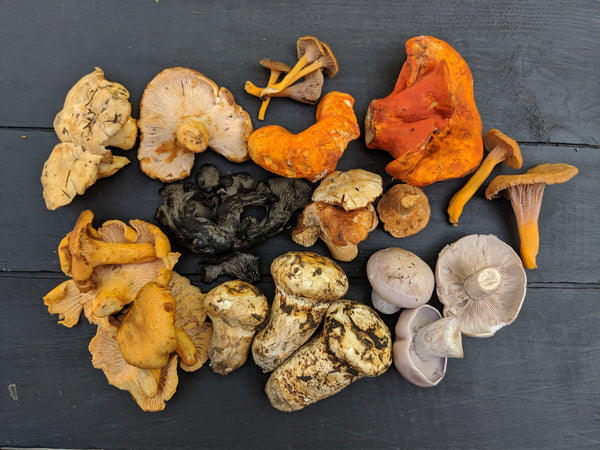
Overharvesting
Overharvesting is not really a major concern with mushrooms. Unlike plants, where removing them from the ecosystem means that they are gone, mushrooms are the fruiting bodies of a much larger organism that lives underground. Just as picking apples won't harm the tree, harvesting mushrooms will not harm the organism. Even if you picked every chanterelle you could in a forest, you would, without a doubt, miss a few that each contain billions of spores. As well, beyond reproducing by spore, most mushrooms can reproduce asexually. And finally, the chanterelle still exists underground ready to fruit again another day. While many mushrooms are abundant, there are some varieties that are now considered endangered, due to loss of habitat, excessive pollution or other significant changes in the environment. Do not enter protected land and avoid picking where it is prohibited.
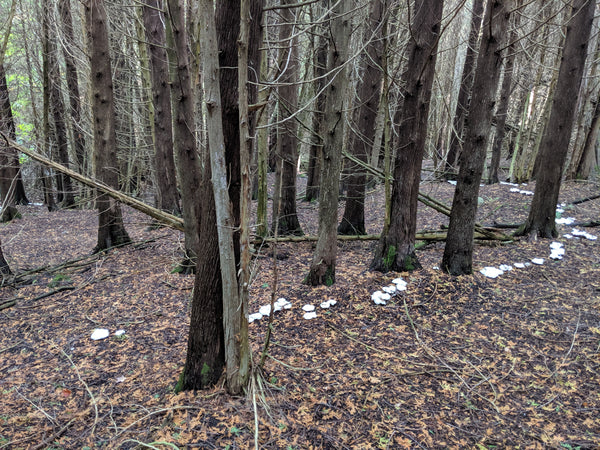
What can cause mushrooms to disappear?
Mushrooms are fully dependant on their hosts, habitat, weather and other food resources. A key reason why mushrooms are abundant one year and scarce the next is weather. Soil temperatures, access to moisture and nutrition are key for many species that like a specific set of conditions. Other factors in mushroom disappearance include pollution, compacting or other soil disturbance, and loss of tree and plant species. As many mushrooms have mycorrhizal (symbiotic) relationship with the roots of various plant species, they require these species to exist in healthy numbers in order that the mushrooms can thrive in that ecosystem. Other mushrooms are parasitic and will only thrive in an environment with many potential hosts with various degrees of resistance.
When you see a fairy ring or a line of mushrooms arching off into the woods, this circle of mushrooms has been moving every year, getting bigger and more spread out as it works its magic as a secondary decomposer, consuming resources in the ground. As the fairy ring matures, what was once was a dense little grouping of mushrooms has arched off into the distance. Its widely spaced "ring members" will eventually trigger other fairy rings that begin again as a tight little circle of mushrooms, moving outward for new sustenance.
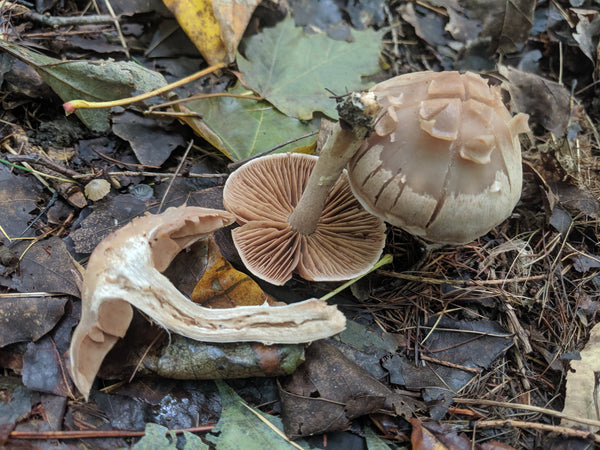
Picking for ID purposes
Picking is essential when trying to learn about a new mushroom. By getting getting your hands on mushrooms, you can tell how firm they are, what kind of texture they have and how they break or rip apart. Looking inside is essential in IDing certain mushrooms. You may be checking for staining, or if using advanced techniques, noting the response to contact with specific chemicals, such as iodine. You can handle any mushroom without risk of poisoning. Even death caps and destroying angels can be handled without worry.
When photographing mushrooms so that other people can help you ID them, it is important to get clear photos of the top and underside of the mushroom as well as a cross section, should there be any staining in the mushroom. Focus on these important details. All the photos in this blog were taken with a cellphone; even mediocre cameras can take good enough shots.
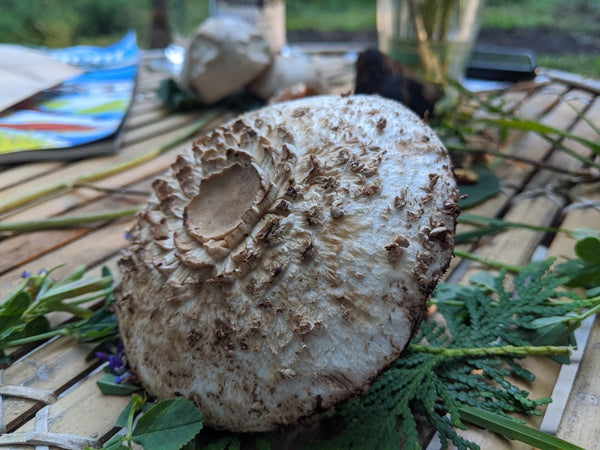
Clear photos of the gills or pores and how the stipe (stem) and cap connect are key features used to ID mushrooms. The cap of this mushroom above looks strikingly similar to the Vomiter (Chlorophyllum molybdites) - a poisonous mushroom with a slight green underside - but closer details show this to be an edible Shaggy parasol (Chlorophyllum rhacodes) with browning on the gills and details on the ring.
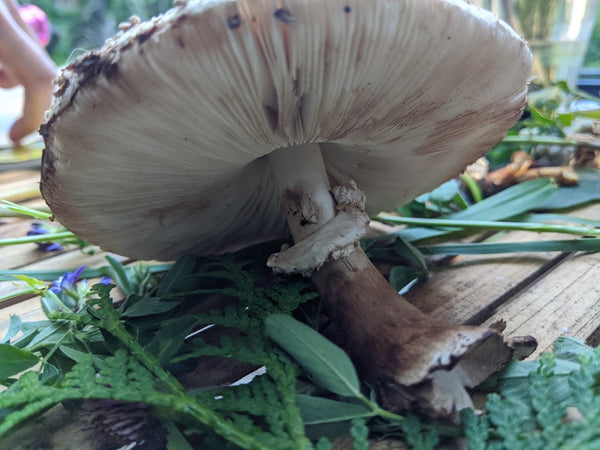
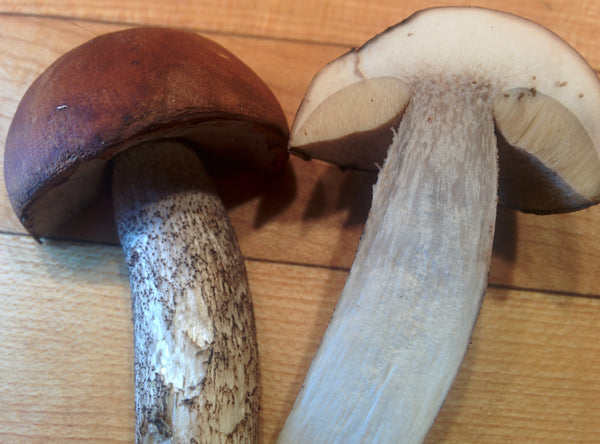
A cross section can help show internal staining. Some mushrooms can flash with a quick burst of blue, while other mushrooms may have more subtle staining with greys and bursts of pink.

Spotting the difference between a Matsutake and a Catathelasma can be difficult, however their gills make telling them apart easy when you know what to look for.

Mushroom picking is a wonderful way to explore and enjoy our forests. It is fun, educational, good exercise, and can lead to exciting and delicious discoveries. When done responsibility, it doesn't adversely impact local ecosystems. On the contrary, it helps us appreciate the need to preserve wild spaces and reveals the value in forests beyond harvesting trees for lumber.
*http://www.fungimag.com
*https://www.wsl.ch
More Posts
-
Get to know the mos...
Autumn is the absolute best time for mushrooms, after a year of growth the cool nights trigger mycelium to shoot out new fruiting bodies and the fo...
Read More
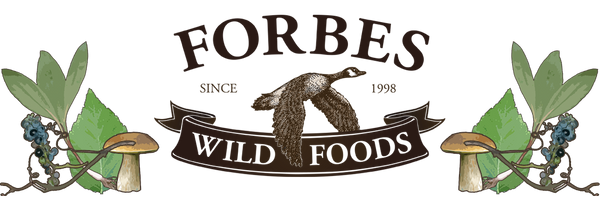



Comments
0 Comments
Leave a Comment